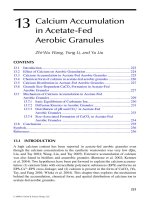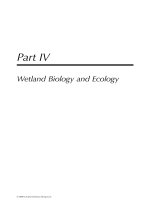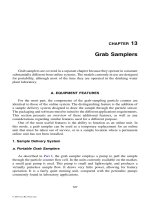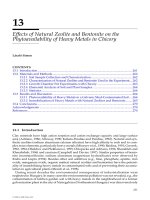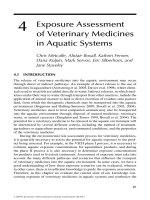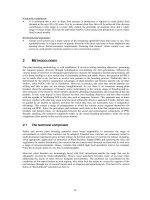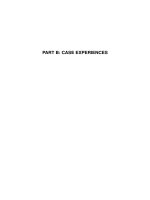BRINGING FARMERS BACK INTO BREEDING - Chapter 13 potx
Bạn đang xem bản rút gọn của tài liệu. Xem và tải ngay bản đầy đủ của tài liệu tại đây (66.13 KB, 4 trang )
99
13 CBDC PHILIPPINES: BOHOLANO FARMERS’ EXPERIENCES ON RED
RICE DEVELOPMENT
13.1 Introduction
13.1.1 Origin of the initiative
Historically, farmers play a great role in the development of crops. The first breeders were farmers who
domesticated wild plants that resulted in cultivated crops grown today. With the introduction of high
yielding varieties (HYVs) in the late 1960s, plant breeding became centralized in research institutions.
Since then, the use of HYVs together with chemical fertilizers and pesticides had a negative impact to
the sustainable farming system of farmers.
Moreover, the introduction of HYVs displaced many traditional rice varieties. In the Philippines, there
were around 3,500 traditional varieties before the government launched Masagana 99, the program that
was mandated to distribute HYVs together with chemical fertilizers, pesticides and loans to farmers.
Despite all these developments at the international and national level, Boholano farmers conserved,
developed and continued to utilize local red rice varieties with assistance of the Southeast Asia
Regional Initiatives for Community Empowerment (SEARICE). It is a Philippine-based
nongovernment organisation (NGO) that directly supports and works with local farmers in on-farm
conservation, utilisation and management of Plant Genetic Resources (PGR) and has been
documenting, disseminating information and results and experience from local farmers’ initiatives on
PGR.
This study documents the Boholano farmers’ experience in red rice breeding. Specifically, it aims to:
1. Determine the breeding objectives for red rice varieties;
2. Examine the red rice seed development process; and
3. Identify problems encountered in breeding red rice varieties.
The municipality of Bilar is 41 kilometre (km) away from Tagbilaran City. Barangay Campagao is one
of the 19 barangays and approximately 10 km away from the town capital. It is an agricultural
community characterized by flat and rolling lands with scattered hills. Most of the rice fields are
irrigated lowland.
The population of Campagao is 7 percent (or 1092) of the total population of 14,926 of Bilar. There are
181 households with 6 members as the average. The people in Campagao are socially active and almost
all are involved in various organisations. Among these is the agriculture-based cooperative, the
Campagao Farmer Research Association, and Farmer’s Association.
SEARICE farmer-partners in Bohol successfully conserve and develop rice genetic resources. Among
the 150 farmer-partners organised through the Community Biodiversity Development and
Conservation (CBDC) Bohol project, five Boholano farmer-breeders were interviewed on their
breeding objectives, seed development process and challenges in breeding red rice varieties These
farmers, namely: Jeremias Rubilla Sr., Venancio Cesar, Gerardo Calamba, Bebiano Adlaon, and
Bonifacia Rebuta shared their transformative experiences on rice breeding and off-type selection.
13.1.2 Breeding objectives
The Boholano farmer-breeders preferred creating their own new variety adapted to their field
conditions. This is specially the case of farmers Rubilla and Cesar who experienced crop failure when
they used the modern varieties provided by a technician from the Philippine Department of Agriculture.
The common breeding objectives are as follows: early maturing, long panicle, strong culm, heavy
weight, pest and disease resistant, aromatic, good eating quality and good selling price. All farmers
preferred a red rice variety since it commands high market price and more nutritional content. These
farmers not only considered their own breeding objectives but also regarded the needs of their fellow
farmers and the need to create economic opportunities with a reliable source of seeds in their
communities.
100
13.1.3 Seed development process
The farmers acquired the much needed knowledge and skills from the Farmers’ Field Schools on PGR
sponsored by SEARICE. The seed development process was primarily influenced by the breeding
objectives of each farmer.
Rubilla chose the F1 from Japan Red and Japan White and crossed them with Hubahib and Hinumay
using a three-way cross method. The F2 cross-bred from Japan Red and Japan White was obtained
through bulk selection method. The F1 (F2 (Japan Red x Japan White) X Hubahib) had the following
characteristics: strong culm, good eating quality, aromatic, heavy grain weight, pest resistant, and the
grains do not easily shatter. The characteristics introduced from the parent material Hubahib are good
eating quality, longer panicles and compact grains. His F1 produce is now maintained in his field
plots.
With the influence of other farmer-breeders in the nearby barangay, Cesar bred Hubahib and Japan
Pula because of their good field performance. Cesar got the seeds as parent materials from another
farmer-breeder. Hubahib served as parent material because of its resistance to pests and diseases and
good grains. Japan Pula was likewise chosen as a breeding material for its resistance to diseases,
strong and big culm, big grains and good eating quality. The resulting variety is named VCC, after his
name Venancio Cabusao Cesar to identify his efforts to other farmers. At F1 stage, the offsprings were
uniform but when they reached F2, the different characteristics from both the father and mother
materials were sgregating. Selection was already practiced at the F2 stage. Cesar selected five different
potential rice varieties which were distributed to other farmers for testing to motivate them to
experience the selection process. He emphasized though that only after the F6-F8 stages does a variety
become uniform and stable.
Another farmer Calamba chose Japan Pula as the father for its red color and big grains which
was paired with RC 18 for its long panicles and high yield although its grains shatter easily.
Using the panicle method of selection, he picked the short and erect panicles with red color
and big grains and was able to generate 9 types, which was named and numbered Radix
Breeding Line (RBL 1-9). From these selections, his neighbours preferred RBL-7 red and
white and RBL-3.
Adlaon first thought that off-types should be removed so that materials will be pure, but he later on
realized through the intervention of SEARICE that single-plant off-type selection was possible and
multiply the ones with superior quality. He then selected an off-type Pilit (sticky rice), and came up
with Red Horse variety with heavy panicles, good milling recovery, compact grains, pest resistant,
aromatic and high yielding. Characteristics not present in Red Horse are short height and big culm, so
that the plants will be sensitive to lodging. His other selections were White Gold, Red 2000 and Beb
2000. Among his four selections, only the Red Horse was maintained, while the other three were
incidentially sold and where shared with fellow farmers not only in Bohol but also in Mindanao.
Rebuta used Red 15, a traditional variety and RC 18, a modern variety as parent planting materials.
Red 15 is commonly planted in her area owing to its red grains, strong culm and early maturing
qualities, while RC 18 is the first modern rice variety widely used by farmers in her area due to its
desirable traits such as high yielding, heavy weight, big grains, long panicles, strong culm and disease
resistance. After four seasons of planting her bred rice, she has maintained four selections.
The seed development process enabled the farmers to reduce farm expenses since they did not have to
buy planting materials. Farm productivity was enhanced with the use of organic fertilizers such as rice
straw and madre de cacao leaves. These farmer-breeders also gained revenues from the sales of their
seeds, aside from the high sales derived from the improved yields of varieties selected.
13.2 Problems encountered
Plant breeding and varietal selection proved to be very tedious processes, yet the farmers were
persistent with their work. Even if other farmers did not appreciate their efforts, they were not
discouraged but were motivated by their desire to attain their breeding objectives of acquiring good
quality seeds and rice diversity.
101
The Philippine Plant Variety Protection Act of 2002 is in conflict with the breeding of farmer-breeders.
Despite this situation, these farmer-breeders did not hesitate to share the seeds with other farmers who
are interested in the newly developed varieties since they believe that no one can claim ownership over
the seeds in the communities. The farmers did not rely on seeds from the government because they self-
sufficient in developing their own varieties.
13.3 Conclusion
SEARICE was the catalyst for development of farmers to realise on their farms conservation, use and
management of PGR. The diversity of red rice in farmers’ field in Bohol illustrates the role of farmers
in increasing genetic diversity. The level of genetic diversity within farmers’ selections is higher than
in modern varieties. Rice breeding helped in establishing a reliable source of planting materials adapted
to local field conditions. The farmer-breeders are not only assured of good quality seeds but are also
empowered with knowledge and skills on plant breeding and varietal selection. These farmers
encouraged their fellow farmers to continue sharing the knowledge, skills and the seeds to other
farmers to promote open access to seed diversity.
102

